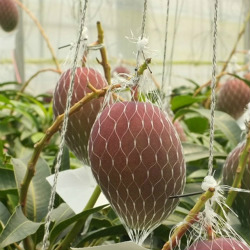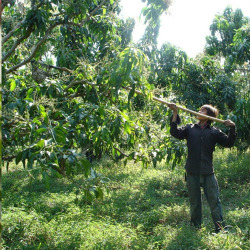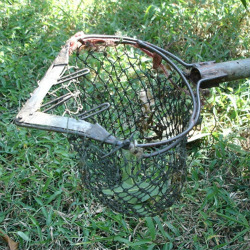Various mango harvesting techniques
Japanese technology, Thai way

Netted ‘Irwin’ fruit to prevent from falling to the ground (Ishigaki, Japan)

Using tools to harvest mango fruit

Structure of the tool tip
About 90% of the mangoes grown in Japan are of the 'Irwin' cultivar bred in Florida, USA. This cultivar is fully ripe when the fruit naturally falls off, and can be eaten deliciously by ripening for two to three days at room temperature. Therefore, nets and fruit bags are used to control and harvest the naturally falling fruit and to prevent it from falling to the ground. This kind of harvesting technique was developed in Japan to suit the greenhouse cultivation of Irwin.
However, other cultivars do not have the same ripening characteristics as ‘Irwin’. Many cultivars become overripe if left on the tree until they drop naturally, causing a disorder called "pulp collapse". Therefore, in regions outside of Japan, it is common to harvest the fruit when it has reached a certain level of coloration and allow it to "ripen" slowly at room temperature for a few days to a week. There are many ways to do this, depending on the cultivar, cultivation method, and region.
For example, in Thailand, where mangoes are cultivated in the open air, the trees are large, so the fruit on the higher elevations are harvested using tools. A common tool is a long bamboo with a blade and a net attached to the end (photo). The photo shows harvesting fruit that is within reach of the ground, but for larger trees, this work is done while climbing the tree.